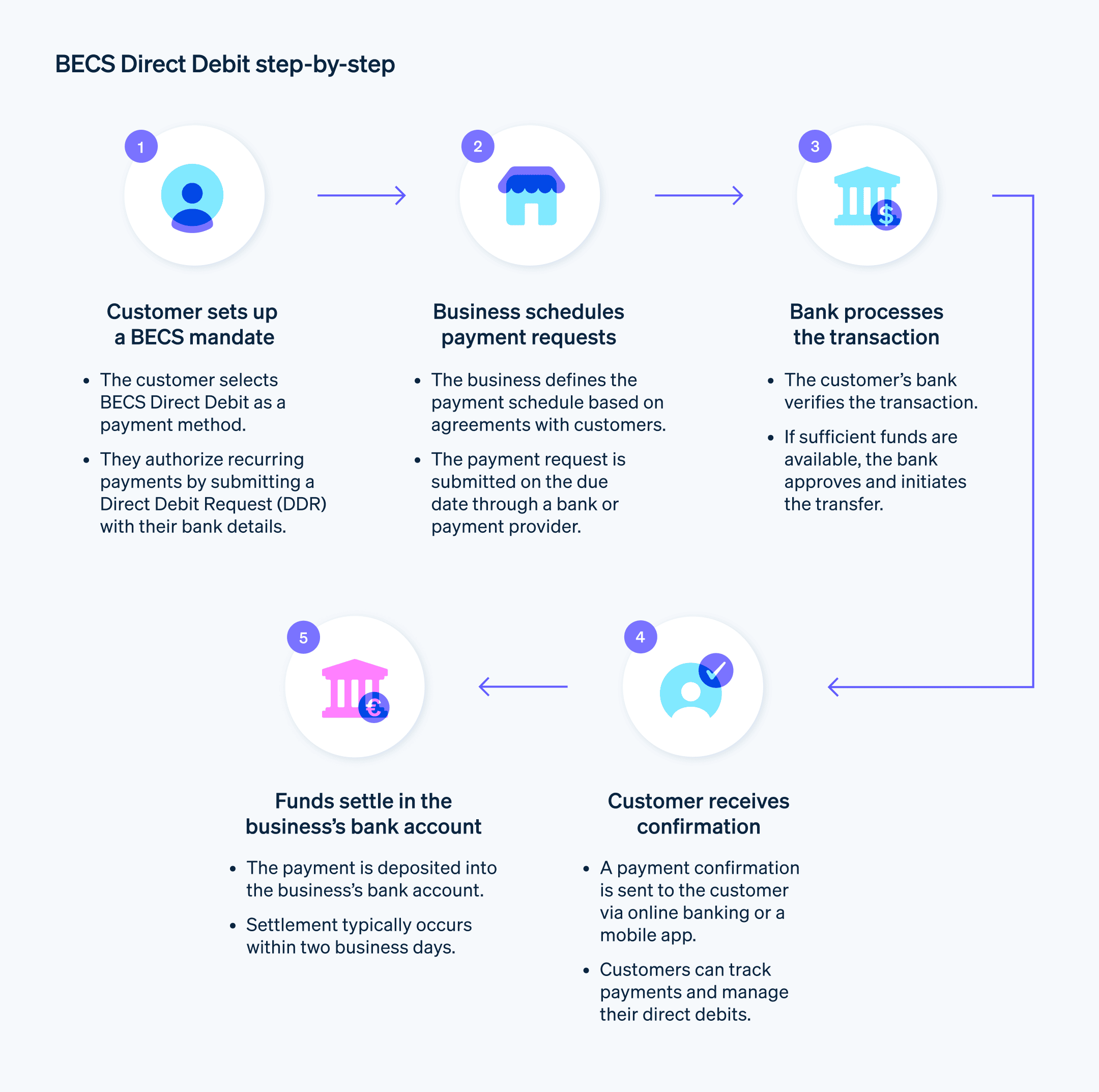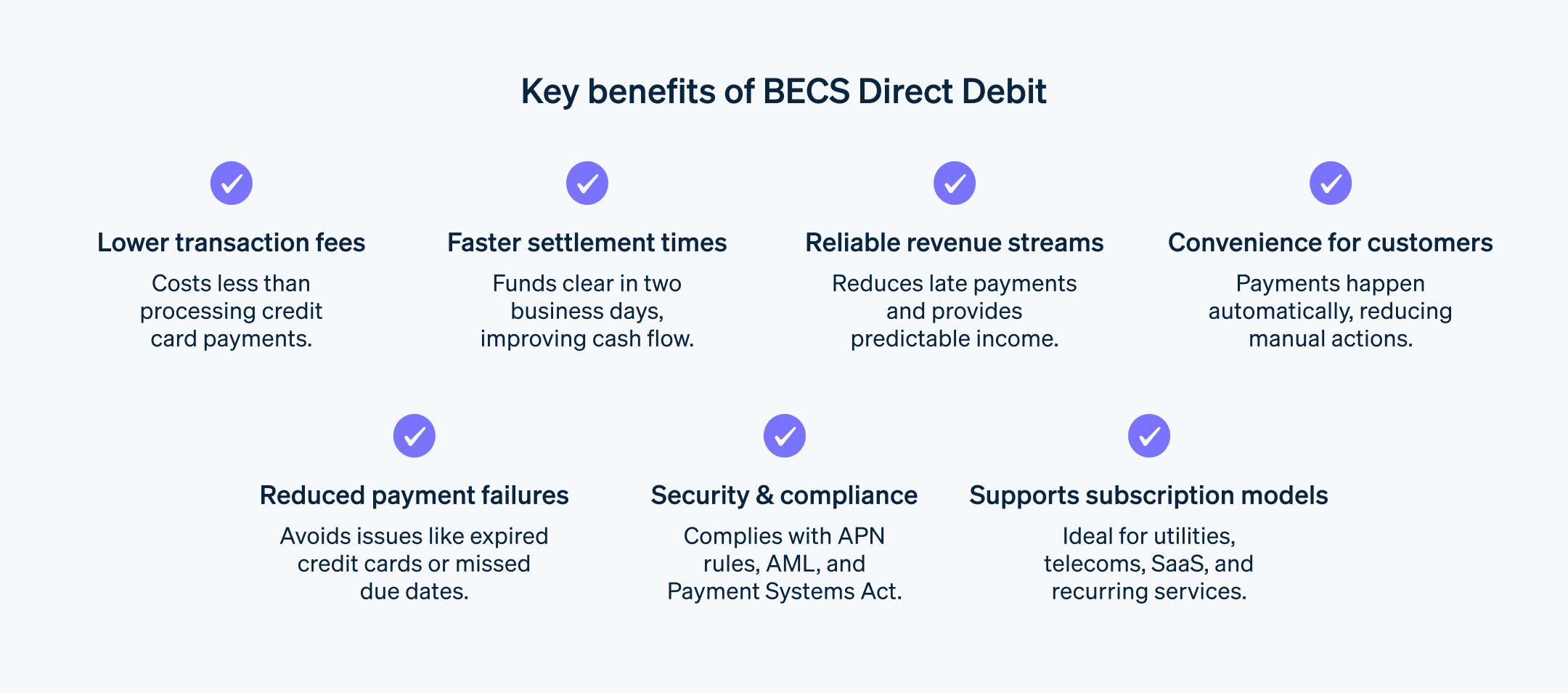BECS-autogiro (Bulk Electronic Clearing System) är ett populärt australiskt banköverföringssystem för återkommande betalningar. Det gör det möjligt för företag att automatiskt samla in auktoriserade betalningar direkt från kundernas bankkonton, en metod som kallas direkt inträde.
Sedan starten 1989 har BECS blivit en vanlig metod för att hantera vanliga räkningar, prenumerationer och medlemskap. Systemet är en viktig del av ekonomin i Australien, där direkt inträde har ett genomsnittligt värde på 15 biljoner australiska dollar (AUD) varje år – majoriteten av kundbetalningarna i landet, baserat på värde.
Nedan kommer vi att diskutera vad företag behöver veta om BECS Direct Debit, inklusive hur det fungerar, vilka kundsegment som använder det och varför, och vad som krävs för att börja använda detta system som betalningsmetod.
Vad innehåller den här artikeln?
- Hur fungerar BECS Direct Debit?
- Hur man accepterar BECS Direct Debit som betalningsmetod
- Fördelar med att ta emot BECS Direct Debit
- Vad är det som driver införandet av BECS Direct Debit i Australien?
- Vem använder BECS Direct Debit?
- Så kan Stripe Payments hjälpa till
Hur fungerar BECS Direct Debit?
BECS Direct Debit förenklar betalningsprocessen för företag och kunder. Så funkar det:
För kunder
- Medgivandekonfiguration: Kunden väljer BECS Direct Debit som sin föredragna betalningsmetod i ett företags kassa eller genom ett separat avtal. De förser sin bank med en begäran om autogiro (DDR), som innehåller deras bankkontouppgifter och ger företaget rätt att debitera specifika belopp med förutbestämda intervall.
- Betalningsbehandling: Om allt är i sin ordning flyttas pengarna från kundens konto till företagets konto. Kunden får ett meddelande, vanligtvis via internetbankportalen eller en mobilapp, om att betalningen har gjorts.
- Medgivandehantering: Kunden har fullständig kontroll över sitt BECS-mandat. De kan välja att avbryta det för att stoppa framtida betalningar helt och hållet. De kan också inleda en tvist om obehöriga eller felaktiga transaktioner med sin bank eller företaget.
För företag
BECS-konfiguration: Företaget integrerar BECS i sitt betalningssystem genom att samarbeta med en bank eller en betaltjänstleverantör. Företaget definierar betalningsplanen och beloppet för varje kund baserat på deras avtal.
Autogiromedgivande (DDI): På förfallodagen/förfallodatumen skickar företaget in ett DDI till sin betalningsleverantör. Detta innehåller information om kund, betalningsbelopp och bankkonto samt ett referensnummer.
Automatisk insamling och avstämning av betalningar: Betalleverantören behandlar DDI och underlättar överföringen av medel från kunden till företaget. Företaget tar emot automatiserade meddelanden och transaktionsregister för avstämningsändamål.
Tvistlösning: Företag är ansvariga för att lösa eventuella tvister som kunder tar upp om obehöriga eller felaktiga BECS-betalningar. Företag måste samarbeta med kunden och deras bank för att nå en lösning inom en överenskommen tidsram.

Hur man accepterar BECS Direct Debit som betalningsmetod
Att acceptera BECS Direct Debit kommer med specifika krav för både australiska och icke-australiska företag. Stripe erbjuder en väg för icke-australiska företag att integrera BECS. Här är kraven för att acceptera BECS-betalningar.
För företag baserade i Australien
Företagsregistrering: Ditt företag måste vara registrerat och ha ett australiskt företagsnummer (Australian Business Number, ABN).
Lokalt bankkonto: Du behöver ett giltigt australiskt bankkonto för att ta emot BECS-betalningar.
BECS-tjänsteleverantör: Du bör samarbeta med en BECS-tjänsteleverantör för att hantera de tekniska aspekterna av clearing och avveckling.
DDR-serviceavtal: Du och din BECS-tjänsteleverantör måste underteckna ett DDR-avtal som beskriver villkoren för behandling av autogirobetalningar.
Efterlevnad: Du måste följa relevanta BECS-regler och föreskrifter från Australian Payments Network (AusPayNet).
För företag baserade utanför Australien
Australisk partner: Du måste samarbeta med en australisk enhet, till exempel ett dotterbolag eller en betrodd partner, som fungerar som din BECS-mottagare och innehavare av bankkontot som kommer att ta emot insättningar.
Stripes BECS Direct Debit-integration: Du kan använda Stripes BECS Direct Debit-funktion för att initiera BECS-betalningar från australiska kunder. Detta kräver:
- Ett Stripe-konto med BECS Direct Debit-funktion
- En betalning som konfigurerats med
au_becs_debitsom betalningsmetod currencyinställd påAUD
- Ett Stripe-konto med BECS Direct Debit-funktion
Steg för att ta emot BECS
BECS-integration: Konfigurera din programvara eller betalningsgateway för att acceptera BECS-betalningar. Stripe erbjuder enkel integration för sina företagskunder.
BECS som betalningsalternativ: Gör BECS tillgängligt i kassan tillsammans med dina andra valda betalningsmetoder.
Kundauktorisering: Kunderna anger sina bankkontouppgifter och accepterar DDR och godkänner därmed betalningen.
Betalningsbehandling: BECS-tjänsteleverantören skickar betalningsbegäran till kundens bank via nätverket.
Avräkning: Pengarna överförs till ditt konto.
Annat att tänka på
Avgifter: BECS-tjänsteleverantörer tar vanligtvis ut avgifter för att behandla autogirobetalningar.
Lägsta betalningsbelopp: Vissa BECS-tjänsteleverantörer fastställer lägsta betalningsbelopp.
Tvistlösning: Förstå tvistlösningsprocessen i händelse av betalningsproblem.
Fördelar med att ta emot BECS Direct Debit
Att acceptera BECS Direct Debit som betalningsmetod ger företag många fördelar, bland annat följande.
Ökad effektivitet och minskade kostnader
Minskad administrativ arbetsbörda: BECS minskar den manuella faktureringen och man behöver inte jaga betalningar, vilket frigör tid och resurser.
Lägre transaktionsavgifter: BECS tar ut betydligt lägre transaktionsavgifter jämfört med kreditkort.
Snabbare avräkningstider: Vanligtvis kommer pengarna in på företagskontot inom två arbetsdagar, jämfört med fem till sju dagar för kreditkortsbetalningar.
Förbättrat kassaflöde och ökad förutsägbarhet
Färre sena betalningar: Autogiro i allmänhet har en mycket hög framgångsfrekvens för auktoriserade transaktioner, vilket avsevärt minskar sena betalningar jämfört med traditionella metoder.
Förutsägbara intäktsflöden: Regelbundna BECS-betalningar ger företag tillförlitliga inkomstprognoser och kassaflödeshantering.
Förbättrad ekonomisk planering: Förutsägbara återkommande inkomster gör det möjligt för företag att planera utgifter och investeringar mer effektivt.
Förbättrad kundupplevelse och kundretention
Praktiskt för kunderna: BECS erbjuder ett bekvämt sätt för kunderna att betala sina räkningar automatiskt, vilket ökar den totala kundnöjdheten.
Minskat kundbortfall: Automatiserade betalningar kan minska kundbortfallet från missade betalningar eller utgångna kort, vilket ökar kundlojaliteten.
Abonnemangstillväxt: Genom att göra återkommande betalningar enklare att installera och använda kan BECS öka ett företags abonnemangsvolym.

Vad är det som driver införandet av BECS Direct Debit i Australien?
Flera nationella trender och fördelar med BECS autogiro har bidragit till ökad användning av betalningssystemet i Australien. Här är några viktiga faktorer:
Digital omställning: I en undersökning från 2021 sa 80 % av australierna att de föredrog att kontrollera sina kontosaldon, betala räkningar och överföra pengar online. Den höga användningsgraden för onlinebetalningar bidrar till BECS popularitet, eftersom kunder enkelt kan ställa in och hantera medgivanden via onlineportaler eller bankappar.
Färre kontantbetalningar: Australien har sett ett skifte bort från kontantbetalningar; Mängden kontantuttag varje månad minskade från cirka 115 miljarder USD 2018 till cirka 78 miljarder USD 2024. BECS stöder denna trend genom att minska behovet av kontanter eller checkar.
Abonnemangsboom: Framväxten av prenumerationstjänster som streamingplattformar, matkassetjänster och SaaS-produkter (software-as-a-service) har ökat efterfrågan på den typ av automatiserade betalningar som BECS erbjuder.
Bekvämt och enkelt att starta: Det är enkelt och okomplicerat att upprätta ett BECS-medgivande för återkommande betalningar på Stripe, och kunderna slipper bekymra sig om att göra betalningarna manuellt.
Transparens och synlighet: Användare kan spåra sina BECS-betalningar via webbanktjänster eller bankappar och få tillgång till detaljerad transaktionshistorik. Denna transparens främjar förtroende och möjliggör ett välgrundat beslutsfattande.
Möjlighet att hantera sin personliga ekonomi: BECS ger användarna de verktyg och den information de behöver för att hantera sina återkommande betalningar på ett effektivt sätt.
BECS följer eller är direkt föremål för många statliga policyer. Detta hjälper det att få dragkraft bland företag och kunder. Det här är några av de viktiga drivkrafterna:
AusPayNet-regler: Dessa standarder, som styr BECS:s verksamhet, fastställer begränsade regler för konsumentskydd, säkerhet och tvistlösning för att säkerställa att processerna är rättvisa och transparenta.
Konkurrens och konsumentlagen 2010: Denna konsumentskyddslagstiftning, som upprätthålls av den australiska konkurrens- och konsumentkommissionen, förbjuder otillbörliga metoder och fastställer att kunderna måste ha tillgång till tydlig och korrekt information om sina rättigheter och skyldigheter.
Payment Systems (Regulation) Act 1998: Denna lag etablerade ramverket för att reglera betalningssystem i Australien. Det kräver att BECS verkar i allmänhetens intresse, på ett sätt som är säkert, effektivt och transparent.
Bekämpning av penningtvätt (AML) och motverkande av finansiering av terrorism (CTF): Denna lagstiftning bidrar till att bekämpa penningtvätt och finansiering av terrorism. BECS uppfyller dessa krav för att skydda det finansiella systemets integritet.
Vem använder BECS Direct Debit?
BECS Direct Debit:s mångsidiga, användarcentrerade tillvägagångssätt för att automatisera, förenkla och säkra finansiella transaktioner gör det till ett populärt val för ett brett spektrum av företag och privatpersoner i Australien. Här är en sammanfattning av vem som använder systemet och varför.
Företagsanvändare och branscher
Samhällsnyttiga tjänster: Gas-, vatten- och elleverantörer i Australien är starkt beroende av BECS-betalningar. Systemet underlättar indrivning av räkningar i rätt tid och sänker behandlingskostnaderna.
Telekommunikation: BECS Direct Debit är idealiskt för telefon-, internet- och kabelleverantörer som tar ut månatliga räkningar. Det erbjuder betalningar i rätt tid, förenklar administrativa uppgifter och kan minska kundbortfall.
Finansiella tjänster: Banker och långivare använder BECS för återbetalning av lån och bolån. Systemets effektivitet och noggrannhet i hanteringen av fasta betalningar är viktiga fördelar.
Försäkringsbolag: Bekvämligheten med BECS-betalningar hjälper till att hantera försäkringsbetalningar.
Abonnemngstjänster: Streamingplattformar, SaaS-leverantörer och onlinepublikationer använder BECS för att samla in återkommande abonnemangsavgifter.
Välgörenhetsorganisationer: BECS förenklar regelbundet givande och gör det möjligt för organisationer att säkerställa kontinuerligt stöd. Eftersom det är så enkelt att starta och hantera är BECS ett effektivt verktyg för insamling.
Myndigheter: Lokala och nationella organ använder BECS för skatteuppbörd, avgifter och utbetalningar av sociala förmåner. Betalningsmetodens effektivitet och transparens gör den idealisk för att hantera ekonomin i den offentliga sektorn.
Detaljhandel och e-handel: BECS används sällan för engångstransaktioner, men systemet underlättar återkommande leveranser och abonnemangsmodeller inom detaljhandeln.
B2B-transaktioner: BECS:s förenklade tillvägagångssätt stöder regelbundna betalningar mellan företag för tjänster och varor. Dessa autogirobetalningar kan minimera den administrativa arbetsbelastningen och förbättra kassaflödet.
Kundsegment
Budgetmedvetna individer: För budgetmedvetna australier är systemets förutsägbarhet i linje med deras fokus på ekonomisk planering och kostnadskontroll. Mer än en fjärdedel (27 %) av australierna sa i en undersökning 2022 att de planerade att ställa in autogiro för vanliga betalningar i ett försök att spara på avgifter för missade betalningar.
Abonnemangstjänster: Många australier använder BECS för att betala för gymmedlemskap, streamingtjänster och andra återkommande betalningar på grund av dess tillförlitlighet och bekvämlighet. Detta bidrar till högre kundbehållning för företag.
Räkningar för samhällsnyttiga tjänster: Australiska hushåll automatiserar ofta sina betalningar av elräkningar genom BECS för att undvika förseningsavgifter och förenkla fakturahanteringen.
Så kan Stripe Payments hjälpa till
Stripe Payments erbjuder en enhetlig, global betalningslösning som hjälper alla företag – från växande startupföretag till globala företag – att ta emot betalningar online, fysiskt och runt om i världen.
Det här kan Stripe Payments hjälpa till med:
- Optimera din upplevelse i kassan: Skapa en smidig upplevelse för kunden och spara tusentals teknikertimmar med förbyggda användargränssnitt för betalningar, tillgång till över 100 betalningsmetoder och Link, Stripes e-plånbok.
- Expandera till nya marknader snabbare: Nå kunder över hela världen och minska komplexiteten och kostnaderna för hantering av flera valutor med gränsöverskridande betalningsalternativ, tillgängliga i 195 länder och för över 135 valutor.
- Skapa en enhetlig betalningsupplevelse i fysiskt miljö och online: Bygg en enhetlig handelsupplevelse i alla digitala och fysiska kanaler för att personanpassa interaktioner, belöna lojalitet och öka intäkterna.
- Förbättrad betalningsprestanda: Öka intäkterna med en rad anpassningsbara, lättkonfigurerade betalningsverktyg, inklusive kodfritt skydd mot bedrägeri och avancerade funktioner för att förbättra auktoriseringstiderna.
- Snabbare utveckling med en flexibel och pålitlig plattform för tillväxt: Bygg vidare på en plattform som är utformad för att skala upp med dig, med 99,999 % upptid och branschledande tillförlitlighet.
Läs mer om hur Stripe Payments kan underlätta dina betalningar online och i fysisk miljö, eller börja idag.
Innehållet i den här artikeln är endast avsett för allmän information och utbildningsändamål och ska inte tolkas som juridisk eller skatterelaterad rådgivning. Stripe garanterar inte att informationen i artikeln är korrekt, fullständig, adekvat eller aktuell. Du bör söka råd från en kompetent advokat eller revisor som är licensierad att praktisera i din jurisdiktion för råd om din specifika situation.